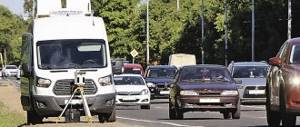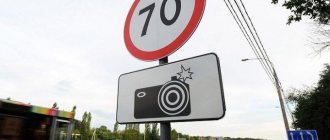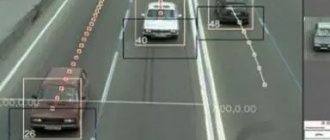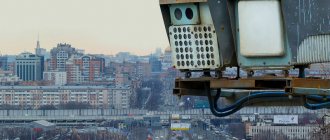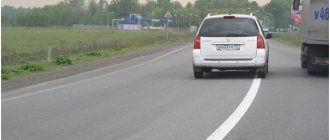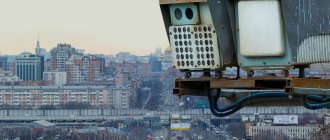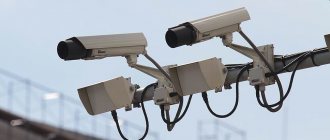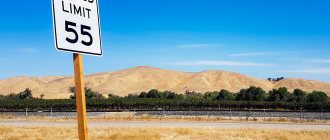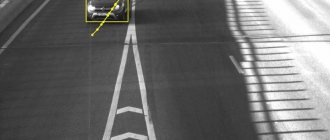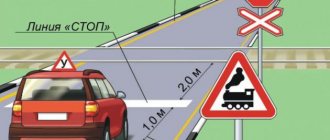TOP 10 most “dangerous” traffic police cameras and radars for drivers
Experienced motorists often feel nostalgic for the times when drivers warned each other about traffic cop ambushes by flashing their headlights. Today we only have to remember this, because strict traffic police inspectors have now been replaced by innovative technologies, such as photo and video cameras, and about which, in fact, there is absolutely no one to warn about them because of their invisibility, and it is useless. The motorist only has to guess about where they are located, and sometimes a radar detector can be a bad help. Below in the article will be a list of the most “harmful”, from the point of view of motorists, photo and video recording cameras.
This unique complex is capable of simultaneously recording 6 violations of traffic rules:
— ignoring traffic light signals;
— driving through an intersection and then turning left to right, in a place where this is prohibited;
- disrespect for people at the pedestrian crossing,
— speed limit violation.
A system such as “Azimuth” easily recognizes reckless drivers from a distance of five kilometers, and it does not matter at all whether the road section is flat or winding.
The purpose of the Odyssey system is to automatically record traffic violations on video and camera and monitor vehicles crossing the control zone:
— record violations of road rules;
— determine the speed of vehicles.
Although the potential of the photo-video recording system is wide, usually only one function is used: to detect a car with a driver not wearing a seat belt, a car running a red light, or speeding.
LISD radar detects short laser pulses reflected from an object.
It has the following advantages:
— its narrow beam focus makes it possible to select the desired vehicle in the general traffic;
- measure its speed;
— take a photo of the license plate from 200 meters away;
- and it is not affected by the weather.
This device looks like binoculars.
You can see such a radar on poles. A highly sensitive 11-megapixel camera easily recognizes vehicle license plates and the face of the driver sitting behind the wheel from a distance of 1000 meters. The camera is capable of recording incorrect parking, driving into oncoming traffic, and driving through a prohibiting traffic light.
The design feature of this device is that it sees the roadway with two “eyes”. Such complexes are very common and work very successfully.
This is a unique automatic control for parking and other violations of road rules. The basis of this technology is a video module that is installed in a police car and a station for processing the resulting video image.
Parkon's purpose is to identify:
— cars that violated parking rules;
— stopping or parking on a road where there is no parking;
- parking on the sidewalk;
— stop at the zebra crossing;
- parking at bus stops, lawns, playgrounds and sports grounds.
What makes this device different from its predecessors is its high fixation accuracy. The information received by Cordon is sent via wireless channels to a computer center, where the information received is analyzed. Such a radar complex is capable of simultaneously monitoring four road lanes.
Here are its main features:
— auto-generation of 2 images;
— automatic control for speeding and driving into oncoming traffic;
— recording violations with subsequent transfer to the computer center;
— full compliance with the specific speed limit of each car in the control zone;
This modern complex is equipped with a video recording camera and is capable of monitoring violations up to 1 km. It should be noted that this device does not track any specific car, but the entire flow of vehicles moving along the road.
The task of this photo radar complex is to automatically record traffic violations. In addition, the device is capable of reading vehicle license plates and tracking them through databases.
Information is transmitted to traffic police posts by telephone, GSM and radio. The data transmitted by the sensor is very reliably protected by the security system built into it.
The task of such a stationary car video monitoring system is to record traffic violations and carry out searches. This complex determines the speed of the vehicle using video frames.
“Avtouragan” has the following characteristics:
— number plate reading in the daytime up to 97%;
— recognition of dirty or damaged registration numbers;
— controls road traffic;
— this complex cannot be “seen” by radar detectors;
— records other violations in addition to speeding;
carries out automatic searches in databases.
This system monitors the speed limit via GLONASS/GPS with a photo recording option. Avtodoria uses two recorders. The first is installed at the very beginning of the controlled area, and the second at the very end.
Avtodoriya records the moment a car passes, records at what time and place it entered and left the controlled area. The received information is transmitted to the server, where the average speed of the vehicle is calculated.
If the speed is exceeded, then a resolution is automatically generated indicating the time and place at which the vehicle committed the violation.
What cameras do the traffic police use to record speed?
The complex provides: Detection of traffic violations with simultaneous recognition of the violator's vehicle's vehicle license plate; Transfer of prepared information, which is the evidence base for the fact of violation of traffic rules, and other data (technical / service); License plate recognition for everyone.
Complex of photo and video recording of violations of traffic rules "Astra-Traffic" Complex of recording of traffic violations "Astra-Traffic" (hereinafter referred to as the complex) is intended for measuring the speed of vehicles (hereinafter referred to as vehicles) in the control zone and on.
Hikvision photo and video recording system is a joint project in the field of security and video surveillance (China) and (Uzbekistan)
The TruCam laser vehicle speed meter is designed to detect traffic violations. TruCam is a device built on the basis of a laser meter, which allows you to reliably identify the vehicle whose speed is being measured at a given time.
The software-analytical complex (PAS) “SOVA” is designed for photographic recording of stopping and parking vehicles, transferring the received data to the server and their software post-processing. PAK "SOVA" records 25 types of violations: Stopping under a sign.
Measuring systems with automatic photo-video recording "DEKART" (hereinafter referred to as systems) are designed for measuring the speed of vehicles in the control zone and on a long section of the road in automatic mode, a.
The Strelka-M photo-video recording complex is the optimal solution for automatic traffic control. Functionally, the complexes are used for photo-video recording of a wide range of traffic violations by approaching and retreating vehicles moving in heavy traffic.
The Poliscan M1 HP vehicle speed measurement system (hereinafter referred to as the system) is designed to measure the speed of vehicles using laser methods in automatic mode. The system calculates the speed.
The purpose of the VIDEO CONTROL-Rubezh complex is round-the-clock automated control of the road traffic situation, recognition of license plates, automatic video recording of vehicles, checking against search registers and analysis of traffic flow according to control criteria in real time, etc.
The MultaRadar SD580 radar vehicle speed meter (hereinafter referred to as speed meters) is designed to measure the speed of vehicles. Distinctive feature: MultaRadar SD580 is a multi-frequency (“bi-Doppler”) radar that simultaneously operates.
The video recording system for traffic violations “Autopatrol Pedestrian” (hereinafter referred to as the system) is designed to automatically detect and register violations of traffic rules (traffic rules), in accordance with Art. 12.18 Code of Administrative Offenses “Failure to provide priority in traffic to pedestrians or others.
The “Autopatrol Parking” video recording system for violations of parking rules (hereinafter referred to as the system) is designed to automatically record violations of the rules of stopping or parking cars on the road or sidewalk. The "Auto Patrol Parking" system is used in places where...
In our country, this system actively began to develop in 2008 - with the adoption of the norms of the Code of the Russian Federation on Administrative Offenses, allowing for bringing to administrative responsibility for traffic offenses detected using automatic means of photography, filming and video recording.
In 2014, the number of traffic violations detected by such devices increased by 138 times compared to 2008! In 2014, over 40 million traffic violations were recorded by systems installed in almost all regions of Russia.
More than 90% of all violations are related to exceeding the established speed limit, which is one of the main reasons for the high mortality rate on the roads.
At the same time, the system of photo-video recording of violations, which is rapidly gaining momentum, like any rapidly developing area, is beginning to outstrip the updating of the regulatory framework regulating its use, as a result of which problems often arise in this activity that affect the stability of the system.
To solve these problems, the Scientific Center collects and analyzes information on supervisory activities using a photo-video recording system, and analyzes the domestic and foreign regulatory framework in this area.
The study showed that while maintaining the dominant share of speeding in violations of the Traffic Rules detected by the system, the vector of further development of the system should be aimed at expanding the composition of recorded violations.
First of all, along with exceeding the speed limit, the devices must record violations that most often cause traffic accidents, in particular: driving through an intersection, entering oncoming traffic, rules for passing a pedestrian crossing, etc. Such experience already exists in Russia.
According to the experts of the Scientific Center, against the backdrop of the process of motorization of the country observed in recent years, a system of photo-video recording of traffic offenses can effectively influence the reduction of road traffic injuries.
This requires improvement of the regulatory legal framework regulating this activity; introduction of qualitatively new photo-video recording systems for traffic violations and implementation of the principle of inevitability of punishment. Cooperation between departments and institutions interested in solving these problems should be aimed at a single result - preserving the life and health of people.
What violations are recorded by traffic police cameras in 2021?
Good afternoon, dear reader.
Every year the number of traffic police cameras recording violations of traffic rules increases. Cameras reduce accidents on the relevant sections of roads, so increasing their number is good news. They make roads safer.
As for drivers, they often ask the question, “what violations are recorded by traffic police cameras?” Let's look at it today. In addition, we will talk about the types of cameras used to record traffic violations.
Who is allowed to use private speed cameras and why?
Cameras can be installed by both individuals and organizations.
Equipment for reliable tracking of speed limit violators is expensive and requires regular maintenance. The benefits for government agencies and individual companies are mutual.
The company installs the equipment at its own expense, maintains it in proper condition and receives a percentage of each amount that the driver who violated the law pays as a fine.
There is always enough speeding on the roads, so there are quite a lot of people who want to make money from it.
This video will tell you why private companies install cameras to record traffic violations on the roads, and what benefits they get from it:
Types of cameras for photo/video recording of traffic violations
First of all, photo and video cameras need to be divided into the following groups:
- Cameras operating in automatic mode.
- Cameras used by traffic police officers when imposing fines.
Cameras for automatically recording traffic violations
The list of traffic violations that can be recorded automatically is not defined by law. Those. In theory, automatic cameras can record any violation of traffic rules.
In practice, cameras are able to record only some violations of the rules, but the list is constantly growing.
I note that cameras operating in automatic mode are divided into:
Portable cameras require daily installation and configuration by traffic police officers. In practice, such cameras only record violations related to speeding.
Stationary cameras are constantly located at the same place on the road (usually on a pole or other support). They only need to be configured once, after which they can detect the following violations:
- Over speed.
- Driving through a prohibiting traffic light.
- Exiting the stop line.
- Entering an intersection when there is a traffic jam.
- Drifting into the oncoming lane.
- Driving on the side of the road.
- Pass under the “No Entry” sign.
- Pass under the sign “Trucks are prohibited”.
- Entering the lane for route vehicles.
- Drive out onto the sidewalk.
- Truck traffic beyond the second lane on highways and roads for cars (MKAD).
- Violation of road marking requirements.
- Making a turn from the second row.
- Low beam headlights or daytime running lights are not turned on.
- Violation of toll rules for heavy trucks.
- Failure to give priority to pedestrians at pedestrian crossings.
Stationary cameras can monitor traffic simultaneously in several lanes, including oncoming lanes.
As technical means are constantly being improved, it is possible that cameras will appear that impose fines for other violations of the rules. If in practice you received an automatic fine that is not on this list, write about it in the comments to the article at the bottom of the page.
For example, the traffic police plans to teach automatic cameras to record a driver’s lack of compulsory motor liability insurance. Checking compulsory motor liability insurance using a single database is not so difficult, so practical implementation will not be long in coming.
Note. Automation of fines for lack of compulsory motor liability insurance has been discussed for several years, but currently (2019) cameras are not able to record this violation.
Mobile cameras are installed in state traffic police vehicles or in public transport. They record violations as these vehicles move.
Mobile cameras can record:
- Over speed.
- Violation of parking rules.
- Violation of toll rules for heavy trucks.
Cameras working together with traffic police officers
Let's move on to considering cameras working together with traffic police officers. In this case, cameras are an additional tool that allows you to confirm the driver’s guilt and impose a fine.
Such cameras can be used to record any violations of the rules . However, unlike automatic cameras, they do not send chain letters. Traffic police officers can only impose a fine manually.
There are several options for using cameras:
- The inspector has the camera. The inspector films the traffic violation on camera and then stops the car.
- The camera is with another inspector. A traffic police officer records a violation of the rules on camera, and then transmits the information to the nearest post. The driver is stopped at the checkpoint and fined.
- Stationary camera in front of the traffic police post. The stationary camera works automatically; it recognizes license plates of passing cars, checks them against databases and transmits information about possible violations to the post. A traffic police officer comes out, stops the car and conducts a check.
Attention! If a traffic police officer is involved in processing documents about a violation, then a fine is imposed as for a regular violation, and not as an automatic one. For example, a driver may lose his license for repeated speeding.
Private cameras recording traffic violations
Private video cameras for recording traffic violations are currently a legal option for bringing car owners to justice under the norms of the Code of Administrative Offenses of the Russian Federation. If the rules for installing the specified controls are observed, the issued resolution will be mandatory for the payment of a fine, and in some cases, for the imposition of a sanction in the form of deprivation of rights.
Video recording equipment for violations on the road can be transferred to private hands on the basis of government contracts concluded between the traffic police service, regional road management departments and legal entities or private entrepreneurs. The subject of these agreements is the operation and ongoing maintenance of video surveillance systems.
The key nuances of such use and placement of surveillance equipment are as follows:
- each complex is subject to inspection and certification in accordance with uniform federal rules, and the operating personnel of private cells must undergo special training;
- placement of private complexes on highways is carried out outside the locations of stationary video surveillance cameras, and their presence should not be indicated by special warning signs;
- the responsibilities of private individuals operating video recording cameras include not only identifying violations, but also printing and delivering decisions imposing fines to specific car owners;
- The operation of private cameras is carried out on a reimbursable basis; legal entities and entrepreneurs receive a fixed portion of the amount of penalties imposed.
The most common option is the use of private video recording equipment on mobile vehicles. In this case, the private owner of the camera has the opportunity not only to record violations, but also to take the necessary measures to protect expensive equipment from illegal actions of third parties. The specified mobile video recording system can be placed in hidden or open mode; the law does not establish restrictions in this regard.
As a rule, these complexes are designed to detect speed limit violations. Video recording systems intended for these purposes can be purchased under government orders by the road maintenance service or by private companies. In the second case, the camera owner must undergo equipment verification and certification, after which an operating agreement can be drawn up.
The accuracy of measuring vehicle speed directly depends on the positioning of the camera on the ground. The standard error of private complexes is about 2 km/h, which is a sufficient indicator according to the norms of the Code of Administrative Offenses of the Russian Federation (as is known, the permissible speed limit under the influence of limiting road signs is up to km/h). If the video recording camera is installed or used incorrectly, the error can reach 7 km/h, which can significantly violate the interests of car owners. Challenging decisions made based on data from private video cameras follows the general rules. The specified document must be sent to the violator, after which a complaint can be filed with a judicial authority within ten days. The challenge procedure in this case is extremely difficult for the following reasons:
- unlike stationary complexes, private cameras can change their location almost daily, which makes it difficult to prove violations when they are installed on the ground;
- at the legislative level there is no official methodology for checking camera installation angles, which makes it possible for unscrupulous owners of the complex to artificially increase the error rate and increase the number of detected violations;
- information about the current speed limit is entered into the software of the complex manually, which is often accompanied by errors (it is extremely difficult even for experienced lawyers to prove that the entered data does not correspond to the traffic sign).
The decision to impose a fine indicates the location of the camera at the time the violation was recorded. To challenge traffic violations recorded by private cameras, you must drive with a video recorder along a highway with installed road signs. Only in this way can it be proven that the calculated indicator of a private video recording camera did not correspond to the permitted speed limit of the road sign. The procedure for holding owners of private cameras accountable for violations of operating and installation rules must be provided for in the terms of the contract.
Installing a sign and applying markings, photo and video recording
In 2021, the traffic rules describe plate 8.23 and horizontal road markings 1.24.4, indicating the presence of photo and video recording cameras on this section of the road.
The indicated sign and markings have been used since 2013. They are discussed in the corresponding article.
However, many drivers still mistakenly believe that there should be a sign and markings in front of each traffic police camera. This statement is incorrect. The camera may not be designated in advance; this will not be a violation.
How it works?
First, you will need to register an individual entrepreneur; if you already have one, you can start following your business plan. The first step will be the purchase of equipment.
The state allows individual entrepreneurs to install cameras at their own expense. The result is a mutually beneficial cooperation: the entrepreneur receives a fixed fee for each fine paid by the violator, and the state does not spend money on the purchase, installation and maintenance of cameras. Funds from paying the fine first go to state bank accounts, after which a recalculation occurs, and the businessman’s share is transferred to the account of his company.
The denser the traffic flow, the more money an individual entrepreneur can earn. It is beneficial to install cameras on highways, in cities filled with traffic, and on difficult sections of the road where violations are likely to be committed.
The state will keep its share. For each violation, the entrepreneur is entitled to a fixed amount of 233 rubles, regardless of the amount of the fine.
The work of the entrepreneur is regulated by the Federal Law “On Concession Agreements”, which specifies where and how video recording equipment should be installed. The new amendments helped expand the opportunities for businessmen, as they allowed the installation of cameras not only on toll roads, but also on regular roads.
What to do if you receive a “letter of happiness” from the traffic police?
Drivers refer to traffic police fines recorded automatically and sent by mail as letters of happiness.
If you have received a “chain letter”, then do not panic. First, you need to make sure that this is a real traffic fine and not a letter from scammers. First of all, check for a fine online. Then call the traffic police department that imposed the fine. You can find the phone number on the official website of the traffic police.
If the fine is not fake, then I recommend paying it without delay. Starting January 1, 2021, a driver can receive a 50 percent discount on a fine if he pays it within 20 days of the violation. Since chain letters are sent by mail, they may reach the driver in one of the last days, so be careful.
If you do not agree with the fine, you can appeal the chain letter . However, you should only do this if you have significant evidence of your innocence.
For example, if another driver was driving at the time of the violation, then he can “take” the fine upon himself.
Another example is the incorrect identification of vehicle license plates. In practice, this sometimes happens. In this case, it will be quite easy to cancel the fine.
There are other situations in which you can appeal a fine.
Note. If the driver tries to challenge the fine by pointing out that the camera was installed incorrectly, then the likelihood of the penalty being canceled is quite low.
To challenge the “letter of happiness”, you should contact the traffic police department that issued the fine. If you cannot visit it in person (the fine was received in another region), you can send a registered letter.
Traffic police video cameras on the roads: what they are and what they control
The number of complexes of photo and video recording of violations of traffic rules is now large, and in the future there will be even more of them. At the beginning of their “career” the cameras only measured speed, but now they are ready to take on even drivers who do not have compulsory motor liability insurance policies. So, what systems are guarded by the traffic police and what violations are monitored.
Cameras are one of the main and hated “enemies” of drivers. The point here is not only in vigilant control, but in incidental situations when the complex does not work correctly and punishes for a violation that did not occur. Similar stories are known, the camera installed in the capital on Marina Raskova Street is especially famous.
New cameras and rehanging old ones
Last fall, Deputy Mayor of Moscow Maxim Liksutov announced plans to increase the number of video recording systems. So, in addition to a hundred cameras, the same number of devices will appear on Mosgortrans buses. In addition, a competition has been announced for the rental of 740 devices, together with which the number of cameras on the capital’s roads will exceed 2 thousand.
By the end of the year, it is planned to change the installation locations of 30% of the cameras, spending 167-168 million rubles on this, since on some streets the devices have fulfilled their task in the fight for road safety - they have reduced the number of violations and accidents to a minimum.
WHOSE CAMERAS ARE THESE?
The traffic police does not install cameras, the head of the State Traffic Inspectorate, Mikhail Chernikov, has repeatedly stated. According to him, five years ago all video recording systems in Russia were transferred to the balances of the regions. According to the law, a private company can enter into a government contract with the region, install cameras at its own expense and receive a fixed amount from each fine issued. In the Moscow region, in addition to the complexes of the state Road Safety Center, there are cameras servicing. Several years ago, it entered into a concession agreement with the government of the Moscow region and became the largest operator of cameras in the region. During 2021, the total number of cameras in the Moscow region should reach 20 thousand - both stationary and mobile. Outsourcing of mobile systems for recording violations is a global practice, explains auto expert and partner of the Autostat agency Igor Morzharetto. According to him, not every region can contain such complexes on its balance sheet, and stories about private owners who bought or rented one camera are generally a myth. “Given the cost of the tripod, the cost of maintenance and sending fines to the violator, an ordinary citizen is unlikely to be able to afford such a business,” Morzharetto clarifies. For example, the most common photo radar “Chris-P”, complete with a mobile post and a data transmission unit, costs about 700 thousand rubles in total. And the cost of newer “Cordon” type devices reaches 2 million rubles. depending on the configuration.
0
What kind of video recording cameras are there?
Systems operating in automatic mode are portable (they only record overspeeding). There are also mobile cameras (placed in traffic police cars and public transport, they detect speeding, violation of parking rules and toll rules for heavy trucks) and, finally, stationary ones. The latter are installed on poles or other supporting structures and are capable of recording a variety of types of violations.
Street Falcon camera
Currently, drivers for the most part are brought to administrative responsibility not by traffic police inspectors, who issue fines on the spot, but through stationary cameras that record photo and video violations of traffic rules. A traffic police officer cannot monitor the road around the clock, but the devices can - they literally “filter” the entire traffic flow during daylight and dark hours and record a number of driving sins.
Types of equipment for fixing speed
Simple video recording devices cannot be used to monitor offenders. The devices must have many additional qualities, be certified and meet the necessary requirements.
There are two types of private speed cameras:
- Mobile complex . Basically, it is installed on tripods in locations approved by the traffic police. Tripods are placed in areas with the highest frequency of traffic accidents;
- Mobile cameras . Such gadgets are attached to the car, removing various violations while driving on the roads.
Portable cameras on a tripod include:
- Photo radar unit;
- Tripod;
- Battery part;
- Cable for connecting to the charger;
- Navigation module.
At the selected tracking point, the main unit is placed on a tripod and connected to the charging box, the energy of which should be enough for a day.
Important components of the main block:
- Multipurpose radar;
- High resolution camera;
- Infrared illumination.
The photoradar sensor records several important parameters:
- Vehicle speed;
- Coordinates of the car in space;
- Fixation time.
Additionally, the package includes a powerful industrial computer, as well as other elements.
What do cameras see?
The main violation of traffic rules recorded by cameras is exceeding the maximum permitted speed. But the systems are able to see a lot of other actions for which a fine is due. This, in particular, is driving along a lane for public transport, the side of the road, a sidewalk, an oncoming traffic lane and tram tracks in the opposite direction, driving against a prohibitory traffic light signal, driving behind a stop line, turning from a lane not intended for such a maneuver, driving behind a stop -line, driving without low beam headlights on, violation of road signs (passing under the “No entry” and “No trucks” signs), not turning on low beam or daytime running lights.
RIA Novosti / Ilya Pitalev
On March 1, Moscow began to issue fines for driving through the characteristic diagonal markings at intersections (aka “waffle iron”), which designate an area where driving is prohibited in traffic jams. For now, only one camera monitoring the “waffle iron” at the intersection of the Garden Ring and Orlikov Lane will punish violators. It is a violation to stop (stationary) a vehicle on a marking for more than five seconds.
RIA Novosti / Vladimir Pesnya
In the future, it is expected that the cameras will begin to fine drivers of cars with low environmental classes who enter zones with restrictions for “dirty” vehicles.
List of violations recorded automatically
Digital technologies have firmly occupied a niche in the field of human life safety. In particular, robotic systems monitor drivers’ compliance with traffic rules. Nowadays it’s even difficult to find streets and highways in cities that don’t have cameras recording violations. At the same time, the list of acts for which a fine is imposed for software is constantly expanding. At the beginning of 2021, the register of traffic violations of automatic recording from traffic police cameras looks like this:
- going to the sidewalk;
- over speed;
- making a turn from the 2nd row;
- driving under a prohibiting traffic light;
- running lights or low beam headlights are not turned on;
- passage under sign 3.1 (“Entry prohibited”, “Brick”);
- crossing the stop line (at intersections and traffic lights);
- crossing road markings in violation of requirements;
- passing under the sign “Trucks are prohibited”;
- violation of the terms of payment for freight vehicles (transponder);
- entering the lane for fixed-route transport (driving in a dedicated lane);
- entering the oncoming lane (through 1 or 2 solid marking lines);
- movement of freight vehicles beyond the 2nd lane on highways and public roads;
- driving through a pedestrian crossing in violation (failure to provide priority to pedestrians to cross in designated areas).
From March 1, 2021, cameras for photo and video recording of violations will identify vehicles in traffic without a technical inspection. Fine 2000 rubles . Therefore, the traffic camera map will help you plan a route if the MOT has expired and you plan to visit the operator for an inspection.
What types of video recording cameras are there and how do they work?
Today, a number of complexes are used on Russian roads. Here are some of them.
One of the most common systems for recording violations of traffic rules in Russia is called “Strelka-ST”. It can record the speed of traffic, as well as control traffic on the oncoming lane, the side of the road, the public transport lane, and punish those who like to drive beyond the stop line and violate the rules for violating the passage of intersections. In addition, it imposes fines on truck drivers who drove in places prohibited for such vehicles. According to some reports, Strelka-ST does not record objects traveling at speeds over 180 km/h, which pays off with “farsightedness” - the camera sees the intruder already at a distance of half a kilometer.
At what distance does the Cordon camera begin to record?
Another new widespread camera for photo-video recording of traffic violations on Russian roads. There are many different modifications of this complex. The most common is Kordon-M4. This complex, like the arrow, uses combined components that measure the speed of vehicles: a radar operating at a frequency of 24.15 GHz and a photo and video camera. According to the technical characteristics indicated on the official website, the length of the control zone of the photoradar unit is only 10-50 meters. As you can see, this complex is noticeably inferior to the technical capabilities of the Strelka complex.
What cameras do the traffic police use on the roads? Video recording card
Traffic police cameras on the map
The cameras that the traffic police use to record violations are perhaps the most important enemies of Russian drivers. Of course, this is not an inspector with whom you can negotiate - cameras can monitor roads for 24 hours, filter traffic flow and still not take a bribe! But the point here is not only the inevitability of punishment - the technology tends to “glitch” and automatically hold citizens accountable for violations that actually did not occur. What cameras does the traffic police use in 2019, what are they able to record and where are they located? We will find out all this in the article.
Where are the cameras located? Official traffic police card
Yes, there is such a map in 2021. Under the auspices of crime prevention, instead of detection, the traffic police has released and maintains up-to-date an official map where you can see within the region and city where auto registration complexes are located.
The disadvantage of such a traffic police map is that it shows only stationary video cameras. Obviously, the portable tools will not be updated daily. But you won’t find these on other resources either - here only radar detectors can help.
To view the location of cameras, select your region in the drop-down list below the map and enlarge the map itself to find the road you need.
What types of fixation are there?
Most often, traffic police fines come from cameras when violations are recorded on stationary cameras. These are installed on poles and other supporting structures at the sides of transport arteries and monitor roads around the clock.
Different complexes have different technical characteristics, “farsightedness,” maximum fixation speed and a list of types of violations that they are ready to track.
In addition to them, portable video recording systems are used that “read” only speeding. Along with them, mobile traffic police cameras can also be used - in 2021 they will be installed on patrol cars and public transport. They see not only violations of the speed limit, but also non-compliance with parking rules, passage of heavy equipment and a number of other traffic violations.
And in some regions, the police have even begun to use drones and balloons, but this is more of an experiment than a rule. Let's take a closer look at the main video recording systems.
What needs to be done before starting such an activity?
To obtain the right to install video recording systems, submit information about speeding to authorities and receive income from this activity, individuals or organizations must win a tender from the state .
The municipality enters into an agreement with the applicant that beats out competitors for a period of 10 to 12 years, during which the contractor’s account will receive interest from the fines paid by the car owners.
An entrepreneur or organization will have to spend approximately a quarter of this period to recoup the costs of purchasing and placing equipment, as well as the costs of its maintenance and repair. But in the subsequent, longer period of time, receipts will form net profit.
The installation locations of such cameras must be approved by the traffic police.
After the end of the period specified in the agreement, the video surveillance systems will become the property of the state.
New cameras 2021
Let's start with the latest and simply new video recording systems that were installed on Russian roads not so long ago. Below we will show you how to find them on the map.
This is one of the newest video recording systems, which is being actively installed in 2021 on Russian roads. On the map you can find them so far mainly in Moscow and Kazan, but they are also spreading in other cities.
Time-tested complexes
Perhaps the most common traffic police video camera on Russian roads is the Strelka ST. She can do the following:
- sees speed limit violators,
- controls traffic in the oncoming lane,
- on the side of the road,
- dedicated lane for public transport,
- crossing the stop line,
- movement of trucks in prohibited places and other violations.
The “vision range” of the camera exceeds 500 m. At this distance, it “catches” the violator in the traffic, “leads” him until he approaches a distance of 50 m, after which he records the violator and his license plate number using a camera. The downside of this system is that it does not respond to objects moving at speeds exceeding 180 km/h.
AvtoUragan-VSM2
This is not just a camera - it is a whole system that combines several photo-video recording complexes, which has a common time synchronization based on a signal from GLONASS/GPS. These traffic police cameras can record 17 types of traffic violations, including:
- over speed,
- driving on red,
- leaving the stop line,
- driving under a prohibiting sign,
- riding on tram tracks,
- sidewalks and bike paths.
The cameras see up to 4 road lanes, record objects at speeds of up to 255 km/h and provide accuracy with an error of no more than 2 km/h.
Autonomous stationary complex consisting of several cameras. It has 12 types of violations that it can capture, including:
- over speed,
- passing a prohibitory signal,
- driving into the oncoming lane,
- turning left or making a U-turn in violation of the markings,
- driving in the opposite direction on a one-way road, and so on.
The camera was created by TCOBDD LLC and reacts to objects moving at speeds of up to 250 km/h. The estimated error is ±1 km/h, the range of operation is classified by the manufacturer. In addition to recording traffic rules, the complex checks license plates for their presence in databases, for example, on the wanted list.
Krechet-SM, SKAT, SKAT-RIF, SKAT-PP
A series of cameras produced by Olvia LLC. Each of them has exceptional specific features. For example, KRECHET-SM provides continuous control with photo recording of all vehicles, SKAT can be used as a stationary or mobile fixing complex, SKAT-RIF works on the same principle as Avtodoriya, providing a mathematical calculation of the speed of movement.
Krechet sees intruders in the range of 10-100 m, SKAT in the range of 5-50 m, and for SKAT-RIF such a range does not matter at all. Any of the systems recognizes violators if they move within 250 km/h.
This complex is designed primarily to identify violators of stopping and parking rules. Parkon-S includes several PTZ street cameras controlled from a single center. Today you can find these funds on the maps of most Russian cities.
The system records cars parked in a given area and sends information about them to a single center: two photos with the date and time, license plate number, location and other information. Sees violators both on his own and on the opposite side of the road.
VOCORD Traffic
The VOCORD Traffic system is capable of recording 15 types of violations, including:
- speed limit violation;
- violation of intersection crossing rules;
- intersection of solid lines;
- violation of parking and stopping rules;
- violation in the pedestrian crossing area, etc.
The complex can include various components and measure speed using both detectors (up to 300 km/h) and optics (up to 250 km/h). The developers claim that the system is not recognized by radar detectors, provides 97% reliability of license plate recognition and passes less than 2% of total traffic.
Mobile and mobile cameras
In addition to stationary ones, the traffic police use cameras in mobile and portable systems. Their use has not become so widespread, since the key condition for their use is control by employees. And the point is not even in ensuring their functionality, but in the fact that such cameras can simply be stolen from the side of the road. The most common such systems are:
- KRIS-P is a mobile photo radar complex that mainly “catches” speeding with the ability to transmit results via a radio channel of data and frames to a remote mobile post;
- ARENA is a mobile system for auto-photo recording of traffic violations, detecting violators on a controlled section of the road, measuring their speed, photographing the violator and transmitting the results to a remote computer via a radio channel;
- AMATA is a laser radar with a wide range of speed measurements from 1.5 to 280 km/h. The minimum distance for measurements is 15 m. It is controlled by traffic police officers using a remote control and provides targeted sampling from the traffic flow.
How is everything going?
An individual entrepreneur or other private entrepreneur invests funds in the purchase of the necessary equipment, namely video recording cameras. It is actively used to catch violators of traffic rules. Both sides are satisfied. The state does not spend a penny on equipment, ensuring smooth traffic on the roads, and yesterday’s unemployed overnight acquired the status of businessmen, as they began to receive income from fines imposed on violators.
The truth is that at the beginning the fine money goes into the coffers of state banks and only after that the businessman receives the money. On highways where there is increased traffic, a businessman is able to achieve stable income due to the dense flow of vehicles. Not all drivers follow traffic rules. Many people violate this, which becomes an axiom for domestic automotive practice.
It should be noted that the state does not return the money to the businessman in full. He keeps some for himself. One fine equals 233 rubles. From the calculation of this amount, a specific percentage was calculated.
Previously, entrepreneurs worked productively on toll highways. Amendments to the Federal Law “On Concession Agreements” made it possible to use video recording equipment on ordinary roads.
Innovations from the traffic police: quadcopters and balloons
Not long ago, traffic police officers took it further - now in their arsenal they also have flying cameras placed on drones and balloons. Their use was first tested back in 2021, but they are not in permanent service until now in 2021.
Of course, they are not so “smart” and cannot independently determine the presence of a traffic violation and transmit information about this to a single center. However, they may well play the role of the “remote eyes” of the inspector and record offenses using a camera. The main thing is that it is an official traffic police camera, which has passed a meteorological check and was certified in accordance with GOST R 57145.
Of course, copters and balloons will not be able to determine the speed of the car. But the location of stationary traffic police cameras is not possible in all places, which cannot be said about the use of aerial equipment. In addition, they can be used without problems in places where there is a significant concentration of cars and help identify violations such as:
- intersection of double solid;
- driving into the oncoming lane;
- violation of travel rules at unregulated pedestrian crossings;
- driving to the side of the road, sidewalk, bike path;
- violation of overtaking rules and so on.
In the meantime, the operation of such means of fixation is not automated, the main thing is that the aircraft are reliable and do not fall on the roofs of cars or the heads of pedestrians!
